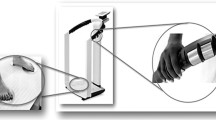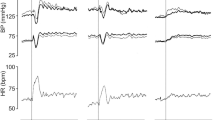Abstract
The cardiovascular response to standing (sit-to-stand change in heart rate; SSΔHR) is commonly employed as a screening tool to detect hypohydration (body water deficit). No study has systematically evaluated SSΔHR cut points using different magnitudes or different types of controlled hypohydration. The objective of this study was to determine the diagnostic accuracy of the often proposed 20 b/min SSΔHR cut point using both hypertonic and isotonic models of hypohydration. Thirteen healthy young adults (8M, 5F) underwent three bouts of controlled hypohydration. The first bout used sweating to elicit large losses of body water (mass) (>3 % sweat). The second two bouts were matched to elicit 3 % body mass losses (3 % diuretic; 3 % sweat). A euhydration control trial (EUH) was paired with each hypohydration trial for a total of six trials. Heart rate was assessed after 3-min sitting and after 1-min standing during all trials. SSΔHR was compared among trials, and receiver operator characteristic curve analysis was used to determine diagnostic accuracy of the 20 b/min SSΔHR cut point. Volunteers lost 4.5 ± 1.1, 3.0 ± 0.6, and 3.2 ± 0.6 % body mass during >3 % sweat, 3 % diuretic, and 3 % sweat trials, respectively. SSΔHR (b/min) was 9 ± 8 (EUH), 20 ± 12 (>3 % sweat; P < 0.05 vs. EUH), 17 ± 7 (3 % diuretic; P < 0.05 vs. EUH), and 13 ± 11 (3 % sweat). The 20 beats/min cut point had high specificity (90 %) but low sensitivity (44 %) and overall diagnostic accuracy of 67 %. SSΔHR increased significantly in response to severe hypertonic hypohydration and moderate isotonic hypohydration, but not moderate hypertonic hypohydration. However, the 20 beats/min cut point afforded only marginal diagnostic accuracy.




Similar content being viewed by others
Notes
Based on different preferences and usage in terminology (Mange et al. 1997; Sawka et al. 2007; Thomas et al. 2008), a generic body water deficit is referred to herein as ‘hypohydration.’ The specific type of hypohydration is accurately described using the tonicity of blood (hypertonic, isotonic, and hypotonic) that results from the body water deficit. ‘Euhydration’ is used to refer to a state of normal hydration (the absence of a measureable body water deficit).
References
Bartok C, Schoeller DA, Sullivan JC et al (2004) Hydration testing in collegiate wrestlers undergoing hypertonic dehydration. Med Sci Sports Exerc 36:510–517
Bealer SL (2003) Peripheral hyperosmolality reduces cardiac baroreflex sensitivity. Auton Neurosci 104:25–31
Beetham WP Jr, Buskirk ER (1958) Effects of dehydration, physical conditioning and heat acclimatization on the response to passive tilting. J Appl Physiol 13:465–468
Black RE, Morris SS, Bryce J (2003) Where and why are 10 million children dying every year? Lancet 361:2226–2234
Carter R III, Cheuvront SN, Vernieuw CR et al (2006) Hypohydration and prior heat stress exacerbates decreases in cerebral blood flow velocity during standing. J Appl Physiol 101:1744–1750
Charkoudian N, Halliwill JR, Morgan BJ et al (2003) Influences of hydration on post-exercise cardiovascular control in humans. J Physiol 552:635–644
Charkoudian N, Eisenach JH, Joyner MJ et al (2005) Interactions of plasma osmolality with arterial and central venous pressures in control of sympathetic activity and heart rate in humans. Am J Physiol Heart Circ Physiol 289:2456–2460
Cheuvront SN, Ely BR, Kenefick RW et al (2010a) Biological variation and diagnostic accuracy of dehydration assessment markers. Am J Clin Nutr 92:565–573
Cheuvront SN, Kenefick RW, Montain SJ et al (2010b) Mechanisms of aerobic performance impairment with heat stress and dehydration. J Appl Physiol 109:1989–1995
Cheuvront SN, Fraser CG, Kenefick RW et al (2011) Reference change values for monitoring dehydration. Clin Chem Lab Med 49:1033–1037
Coleman TG, Norman RA Jr, Manning RD Jr (1975) Equilibrium between extracellular and intracellular fluid. In: Guyton AC, Taylor AE, Granger HJ (eds) Circulatory physiology II: dynamics and control of the body fluids. W. B. Saunders Company, Philadelphia, pp 225–242
Convertino VA, Rickards CA, Ryan KL (2011) Autonomic mechanisms associated with heart rate and vasoconstrictor reserves. Clin Auton Res [Epub ahead of print]
Cooke WH, Ryan KL, Convertino VA (2004) Lower body negative pressure as a model to study progression to acute hemorrhagic shock in humans. J Appl Physiol 96:1249–1261
Dill DB, Costill DL (1974) Calculation of percentage changes in volumes of blood, plasma, and red cells in dehydration. J Appl Physiol 37:247–248
Dutoit AP, Hart EC, Charkoudian N et al (2010) Cardiac baroreflex sensitivity is not correlated to sympathetic baroreflex sensitivity within healthy, young humans. Hypertension 56:1118–1123
Feig PU, McCurdy DK (1977) The hypertonic state. N Engl J Med 297:1444–1454
Fraser CG, Harris EK (1989) Generation and application of data on biological variation in clinical chemistry. Crit Rev Clin Lab Sci 27:409–437
Frey MA, Lathers C, Davis J et al (1994) Cardiovascular responses to standing: effect of hydration. J Clin Pharmacol 34:387–393
Gao SA, Johansson M, Hammaren A et al (2005) Reproducibility of methods for assessing baroreflex sensitivity and temporal QT variability in end-stage renal disease and healthy subjects. Clin Auton Res 15:21–28
Gennari FJ, Kassirer JP (1974) Osmotic diuresis. N Engl J Med 291:714–720
Haditsch B, Roessler A, Hinghofer-Szalkay HG (2007) Renal adrenomedullin and high altitude diuresis. Physiol Res 56:779–787
Hyatt KH, Jacobson LB, Schneider VS (1975) Comparison of 70 degrees tilt, LBNP, and passive standing as measures of orthostatic tolerance. Aviat Space Environ Med 46:801–808
Institute of Medicine (2005) Dietary reference intakes for water, potassium, sodium, chloride, and sulfate. National Academies Press, Washington, DC
Johnson DR, Douglas D, Hauswald M et al (1995) Dehydration and orthostatic vital signs in women with hyperemesis gravidarum. Acad Emerg Med 2:692–697
Knopp R, Claypool R, Leonardi D (1980) Use of the tilt test in measuring acute blood loss. Ann Emerg Med 9:72–75
Kubica R, Nielsen B, Bonnesen A et al (1983) Relationship between plasma volume reduction and plasma electrolyte changes after prolonged bicycle exercise, passive heating and diuretic dehydration. Acta Physiol Pol 34:569–579
Lennquist S (1972) Cold-induced diuresis. A study with special reference to electrolyte excretion, osmolal balance and hormonal changes. Scand J Urol Nephrol 9(Suppl 9):1–142
Levitt MA, Lopez B, Lieberman ME et al (1992) Evaluation of the tilt test in an adult emergency medicine population. Ann Emerg Med 21:713–718
Mange K, Matsuura D, Cizman B et al (1997) Language guiding therapy: the case of dehydration versus volume depletion. Ann Intern Med 127:848–853
Manning EP, Wilson B (2007) Dehydration in extreme temperatures while conducting stability and support operations in a combat zone. Mil Med 172:972–976
Manz F (2007) Hydration and disease. J Am Coll Nutr 26:535S–541S
McGee S, Abernethy WB III, Simel DL (1999) The rational clinical examination. Is this patient hypovolemic? JAMA 281:1022–1029
Meendering JR, Torgrimson BN, Houghton BL et al (2005) Menstrual cycle and sex affect hemodynamic responses to combined orthostatic and heat stress. Am J Physiol Heart Circ Physiol 289:631–642
Mitchell JW, Nadel ER, Stolwijk JA (1972) Respiratory weight losses during exercise. J Appl Physiol 32:474–476
Nose H, Mack GW, Shi XR et al (1988) Shift in body fluid compartments after dehydration in humans. J Appl Physiol 65:318–324
Robertson GL, Mahr EA, Athar S et al (1973) Development and clinical application of a new method for the radioimmunoassay of arginine vasopressin in human plasma. J Clin Invest 52:2340–2352
Sawka MN, Young AJ, Pandolf KB et al (1992) Erythrocyte, plasma, and blood volume of healthy young men. Med Sci Sports Exerc 24:447–453
Sawka MN, Burke LM, Eichner ER et al (2007) American College of Sports Medicine position stand. Exercise and fluid replacement. Med Sci Sports Exerc 39:377–390
Stallings SB, Childress KJ, Maynard SM et al (1979) Comparison of natriuretic and diuretic effects of single and divided doses of furosemide. Am J Hosp Pharm 36:68–71
Stanforth PR, Gagnon J, Rice T et al (2000) Reproducibility of resting blood pressure and heart rate measurements. The HERITAGE Family Study. Ann Epidemiol 10:271–277
Steiner MJ, Nager AL, Wang VJ (2007) Urine specific gravity and other urinary indices: inaccurate tests for dehydration. Pediatr Emerg Care 23:298–303
Thomas DR, Cote TR, Lawhorne L et al (2008) Understanding clinical dehydration and its treatment. J Am Med Dir Assoc 9:292–301
Tran ZV (1997) Estimating sample size in repeated-measures analysis of variance. Meas Phys Educ Exerc Sci 1:89–102
Warren JL, Bacon WE, Harris T et al (1994) The burden and outcomes associated with dehydration among US elderly, 1991. Am J Public Health 84:1265–1269
Wieling W, van Lieshout JJ (2008) Maintenance of postural normotension in humans. In: Low PA, Benarroch EE (eds) Clinical autonomic disorders. Lippincott, Williams and Wilkins, Philadelphia, pp 57–67
Witting MD, Gallagher K (2003) Unique cutpoints for sitting-to-standing orthostatic vital signs. Am J Emerg Med 21:45–47
World Health Organization (1995) The treatment of diarrhoea: a manual for physicians and other senior health workers. WHO Press, Geneva
Zweig MH, Campbell G (1993) Receiver-operating characteristic (ROC) plots: a fundamental evaluation tool in clinical medicine. Clin Chem 39:561–577
Acknowledgments
We thank our soldier volunteers for their study participation and for their military service. We also appreciate the expert technical assistance afforded to us by Kurt Sollanek, Myra Jones, Jeff Staab, SPC Marissa Spitz, and Mary C. Pardee.
Conflict of interest
None of the authors had a conflict of interest. The opinions or assertions contained herein are the private views of the authors and should not be construed as official or reflecting the views of the Army the Department of Defense. Approved for public release: distribution unlimited.
Author information
Authors and Affiliations
Corresponding author
Additional information
Communicated by Narihiko Kondo.
Rights and permissions
About this article
Cite this article
Cheuvront, S.N., Ely, B.R., Kenefick, R.W. et al. Hydration assessment using the cardiovascular response to standing. Eur J Appl Physiol 112, 4081–4089 (2012). https://doi.org/10.1007/s00421-012-2390-0
Received:
Accepted:
Published:
Issue Date:
DOI: https://doi.org/10.1007/s00421-012-2390-0




